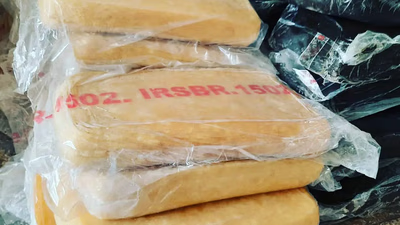
SBR production in West Asia: A key commodity trade hub.
West Asia is known for its abundant reserves of crude oil and natural gas. These resources serve as the raw materials for the production of synthetic rubbers like SBR. The availability of petrochemical feedstocks in the region provides a competitive advantage for SBR production. West Asia has developed a robust and integrated petrochemical industry. The region has invested in establishing petrochemical complexes and infrastructure, which allows for the efficient production and processing of various petrochemical products, including SBR. The presence of supporting industries and infrastructure facilitates the manufacturing of SBR in the region.
SABIC is a leading manufacturer of petrochemicals and synthetic rubber, including SBR. It operates several production facilities in Saudi Arabia and has a significant presence in the Middle East market. NPC, based in Iran, is a major petrochemical company that produces a range of products, including SBR. It operates various petrochemical complexes and has a significant share in the regional SBR market. Petro Rabigh is a joint venture between Saudi Aramco and Sumitomo Chemical, located in Saudi Arabia. It produces a wide range of petrochemical products, including SBR, and serves both domestic and international markets.
IBR, based in Iran, is a leading manufacturer of butyl rubber and SBR. It has a production facility capable of producing various grades of SBR for different applications. GPIC, located in Bahrain, is a major petrochemical producer in the Middle East. While their primary focus is on fertilizers, they also produce SBR and other rubber products. These are just a few examples of SBR manufacturers in West Asia (Middle East). It's important to note that the availability and specific manufacturers may vary over time and it's advisable to refer to industry directories, trade publications, and local business databases for the most up-to-date information on SBR manufacturers in the region.
Governments in West Asia have recognized the economic importance of the petrochemical industry and have provided support and investment incentives to encourage its growth. This support includes infrastructure development, tax benefits, research and development initiatives, and favorable regulatory frameworks. These measures attract investments from both local and international players, leading to the establishment of multiple SBR manufacturing facilities. Petrochemical companies in West Asia aim to diversify their product portfolios to reduce reliance on crude oil exports and capture higher value-added segments of the petrochemical industry. Producing SBR and other synthetic rubbers allows these companies to expand their product offerings, cater to different market segments, and enhance their competitiveness in the global petrochemical market.
Middle East Chemical Industry Companies has the ability to supply all types of styrene butadiene rubber SBR for all safe ports of the world ASWP. The minimum required tonnage must be more than 1000 tons. The company has an extensive sales network of petrochemical and refinery products throughout Asia, Europe and Africa, as well as engineers and experts in branches of oil, gas and petrochemicals as one of the strongest companies in this Is the domain.
West Asia's geographical location offers proximity to major markets in Asia, Europe, and Africa. This strategic location provides logistical advantages for the export and distribution of SBR to these regions. The Middle East acts as a bridge between producers and consumers, facilitating trade and accessibility to global markets. The demand for synthetic rubbers, including SBR, is increasing globally due to the growth of industries such as automotive, construction, and consumer goods. West Asia serves as a significant market for SBR, as well as a base for exporting to regional and international markets. The presence of multiple manufacturers in the region helps meet the growing demand and capitalize on the market potential.
-

Styrene Butadiene Rubber (SBR) is a synthetic elastomer made from the copolymerization of styrene and butadiene. Its properties can be tailored by adjusting the ratio of these monomers, resulting in various grades suitable for diverse applications. SBR is known for its excellent abrasion resistance, flexibility, and resilience, making it ideal for industries requiring durable materials. The typical density of SBR ranges from 0. 92 to 0. 94 g/cm³, with hardness varying between 50 to 90 Shore A. Its tensile strength generally falls between 10 to 25 MPa, and it exhibits elongation at break from 300% to 800%. SBR maintains its mechanical properties even in low temperatures and offers moderate tear resistance.
While it has fair electrical insulation properties, it is not recommended for high-resistance applications. The versatility of SBR allows for modifications through additives and fillers to enhance specific characteristics like heat or oil resistance. This adaptability makes SBR a cost-effective alternative to natural rubber across various sectors.
-

West Asia"s rich reserves of crude oil and natural gas provide a competitive edge in the production of Styrene Butadiene Rubber (SBR). The region boasts a well-established petrochemical industry, supported by significant investments in infrastructure and production facilities. Key players like SABIC, NPC, Petro Rabigh, IBR, and GPIC dominate the SBR market, leveraging local resources to cater to both domestic and international demands. Governments in West Asia recognize the economic significance of this sector and offer incentives to stimulate growth, including tax benefits and infrastructure development. This strategic support has led to the establishment of numerous SBR manufacturing facilities aimed at diversifying product portfolios beyond crude oil exports. The geographical advantage of West Asia facilitates efficient logistics for exporting SBR to major markets across Asia, Europe, and Africa. As global demand for synthetic rubbers rises—driven by industries such as automotive and construction—West Asia is positioned as a crucial supplier. The region not only meets local needs but also serves as a vital hub for international trade in SBR. "
-

Natural rubber and styrene butadiene rubber (SBR) differ significantly in origin and properties. Natural rubber is sourced from the sap of the Hevea brasiliensis tree, making it a renewable resource, while SBR is a synthetic product derived from petroleum through polymerization. Both materials are elastomers, exhibiting flexibility and the ability to return to their original shape after deformation. However, SBR can be processed more easily and has superior heat resistance compared to natural rubber. The cost-effectiveness of SBR makes it a popular choice in various industries, including automotive and construction. Natural rubber excels in elasticity and resilience, making it ideal for high-performance applications like tires and seals. Both types can be modified with fillers and additives to enhance specific properties such as abrasion resistance and tear strength. Environmental implications also differ; natural rubber is more sustainable due to its renewable nature, while SBR"s production has a higher environmental impact.
Ultimately, the choice between natural rubber and SBR depends on the specific requirements of the application, including performance needs, cost considerations, and environmental factors. "
-

The automotive industry, particularly tire manufacturing, is the largest consumer of Styrene Butadiene Rubber (SBR), utilizing it for its essential properties such as abrasion resistance and durability. SBR is crucial in producing tires, accounting for approximately 70% of its consumption. This polymer enhances tire performance by providing better grip and wear resistance, ensuring safety on the road. Beyond tires, SBR is also used in various applications including footwear, conveyor belts, adhesives, and construction materials due to its flexibility and resilience. The demand for SBR is closely linked to the growth of the automotive sector globally, as it supports the production of passenger vehicles and commercial trucks. Despite having lower mechanical properties compared to natural rubber (NR), SBR"s cost-effectiveness and availability make it a preferred choice in many industries. Its versatility allows it to be utilized in products ranging from shoe soles to industrial hoses, highlighting its significance in both consumer and industrial markets. "
-

SBR (Styrene Butadiene Rubber) requires careful handling during transportation and storage to maintain its quality. It is typically transported in bulk containers, such as bags or drums, and should be protected from moisture, contamination, and physical damage. Ideal storage conditions include a clean, dry environment with temperatures below 25°C (77°F) to prevent degradation. Proper ventilation is essential to avoid mold growth, while exposure to direct sunlight and extreme temperatures must be minimized. During loading and unloading, care should be taken to prevent spills or damage. SBR should be stored away from reactive substances like acids and oils to avoid contamination. Implementing an inventory management system that follows the FIFO principle helps ensure older stock is used first. Regular inspections are necessary to monitor for signs of degradation or damage.
Compliance with local regulations regarding the transportation and storage of SBR is crucial for risk management. Petroleum traders can expand their offerings by including SBR in their product portfolio, catering to a wider customer base while ensuring safe logistics practices are followed.
-

SBR, or Styrene Butadiene Rubber, is a synthetic rubber known for its versatility and cost-effectiveness. By adjusting the styrene-to-butadiene ratio and incorporating various additives, SBR can be tailored to meet specific application needs across diverse industries. Its favorable properties include good tensile strength, flexibility at varying temperatures, and resistance to abrasion, making it suitable for applications in tire manufacturing, footwear, and construction materials. SBR is also relatively inexpensive due to the availability of its raw materials. However, it has limitations such as low resistance to hydrocarbon solvents and certain environmental factors. Safety precautions are necessary when handling SBR to avoid skin contact and inhalation of dust. Despite these disadvantages, SBR"s compliance with regulatory standards enhances its appeal in global markets. The ability to customize SBR"s properties allows businesses in the Middle East and West Asia to leverage this material effectively within their supply chains.






